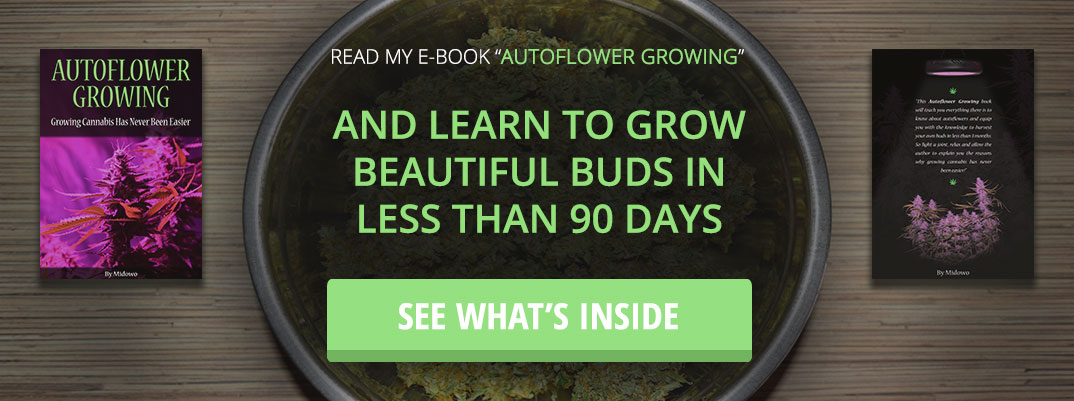What is mold? How does it affect autoflowering cannabis plants?
Mold is a fungus that actively damages the living content of the material that it is growing on, and autoflowering cannabis plants are no exception. Your autoflowering cannabis plants can fall prey to mold during any stage of their growth cycle.
Do note that your plants are most vulnerable to mold during their vegetative and flowering stage, but your buds can catch mold as they are being dried or cured.
Once mold starts growing on your cannabis plant, it will rot its roots, absorb its nutrients, stunt its growth, and weaken it.
If left unattended, mold can kill autoflowering cannabis plants over time!
While smoking moldy cannabis will not kill you, it is not recommended! Fungi such as molds are linked to various allergic and asthmatic diseases.
A study from US Davis that assessed the risk of infection from fungi on marijuana concluded that cannabis with fungal colonies is not fit for consumption. You could be allergic to mold, without knowing it. If so, smoking moldy weed could trigger coughing, wheezing, congestion, and other respiratory issues. It may also lead to sinus pain and headaches.
If you are looking to relax by smoking weed to enjoy your high, then moldy weed is too much of a gamble!
How can autoflowering plants get mold?
As mold are fungi, they thrive in warm, damp, and humid environments. They reproduce through spores that need a bit of warmth and moisture to begin developing into fungal colonies. Spores can get stuck to your clothes, body, or equipment and be transported to where your autoflowering cannabis plants are growing.
Once they are in your growing space, spores can latch themselves onto plant material and remain dormant until the environmental conditions are suitable enough for them to begin growing.
Your growing space can become a hotbed for fungal growth if:
- It is not ventilated well.
- Cannabis plants do not have enough space between them.
- The environment is more humid than required.
- The temperature is not managed appropriately.
Any combination of these aspects can create an inviting environment for mold to take over your autoflowering cannabis garden.
How to identify if my plants have caught mold?
Mold has a powdery coating that is typically grey or white in color. However, if you are not a seasoned cannabis cultivator, then you could mistake trichomes for mold.
Trichomes are shiny hair-like structures that are packed with psychoactive content and the characteristic aroma of cannabis.
Identifying mold in its earlier stages can be tricky, so here are the most common types of mold and how to identify them:
Powdery Mildew
Imagine dusted flour sprinkled all over the surface of your autoflowering cannabis plant. That is what powdery mildew looks like.

Photo credit: Mikal from onegoodyear.com
It usually starts as circular white spots and then spreads outwards as patches on the surface of your plant’s leaves and its undersides too! It is common to confuse powdery mildew with trichomes. However, closer inspection will reveal that powdery mildew does not glisten or shine like trichomes.
Botrytis
Botrytis, or grey mold, is another common mold that can develop inside your marijuana buds. If grey mold has seized your buds, then you may notice that its surrounding leaves will start dying.
The most common cause of botrytis is excess moisture in the environment and high levels of humidity. If you suspect your autoflowering cannabis plant is infected with grey mold, then you need to inspect the inside of your buds and discard them.
Fuzzy White Mold
Fuzzy white mold is most likely to seize your cannabis garden in the last few weeks of your plant’s growth cycle near harvesting time. Unlike most molds, fuzzy white mold grows best in relatively cooler temperatures (20 degrees Celsius).
This fungus is identified through the presence of grey hairs on buds accompanied by the yellowing or browning of leaves on your autoflowering cannabis plant.
How to treat mold if your cannabis plants have it?
Getting rid of mold that has infected your cannabis plant’s leaves and buds can be incredibly challenging.
It may be possible to get rid of the fungus by disposing of the infected buds and letting your autoflowering cannabis plant grow in a new environment. Still, even then the mold can propagate through spores and return.
Some sources may claim to heat your buds at a temperature that is a little less than the combustion temperature for marijuana. Unfortunately, excessive heat exposure can cause fungal spores to become dormant, but they will reactivate once have favorable environmental conditions.
Much like food that has gone moldy, the best solution is to get rid of your moldy cannabis plant before it infects others in your growing space!
How to prevent mold on autoflowering cannabis plants?
Protecting your autoflowering cannabis plant from mold is the most effective means of ensuring that your cannabis garden does not fall prey to a fungal epidemic.
Here is what you can do to prevent mold from growing on autoflowering cannabis plants:
Humidity
Do not let humidity in your cannabis garden exceed 60%. Moisture above this level is a recipe for disaster and an open invitation for mold to settle on your plants.
Pro-tip: Use dehumidifiers or humidity packets!
Airflow
Install fans that cause a vortex of air to be created just below the canopy of your plants. Make sure that the intensity of your fans is not overwhelming for your cannabis plants.
Location
The storage location of your autoflowering plants and buds needs to be dry to discourage mold spores from germinating. Make sure there is enough space between your cannabis plants.
Conclusion
Finding mold spread on your autoflowering cannabis plants is a rather sticky situation that is best avoided.
Smoking moldy weed is dangerous and can lead to some serious health complications as documented in case studies that focus on marijuana and Pulmonary Aspergillosis.
Note that the best solution to mold is to prevent it in the first place!







